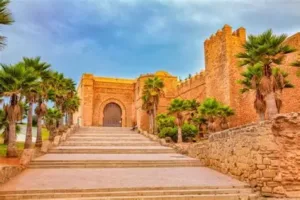From beautiful beaches to stunning deserts and imposing mountains, Morocco’s diverse geography makes it it one of the world’s most alluring countries.
In addition to its spectacular natural scenery, Morocco is also known for its magnificent handicrafts. Visit its souks and discover textiles, carpets, leather goods, furniture, jewelry, and world-renowned Moroccan rugs. While the list of Morocco’s attributes is endless, here are six reasons why Morocco should be your next vacation destination
1. Great Weather
No matter the time of year, Morocco’s weather will rarely disappoint. The country’s diverse terrain – a coast on the west, Rif Mountains in the north, the Atlas Mountains in the interior, and the Sahara Desert to the south and east – result in a variety of weather, rendering it an ideal destination all year.
Winter months, for instance, provide sunny and bright days accompanied by cooler, crisp nights, with temperatures typically reaching the high teens.

During the spring months of March, April, May, and June, the weather gradually warms to low to high twenties throughout the day and warmer nights.
While July and August are undoubtedly hot, with inland temperatures reaching 46 degrees Celsius, the heat is dry and humidity infrequent. At this time of year, while southern Morocco, particularly Marrakech and Fez, can be extremely hot, the coast is a great destination.
With temperatures in the upper 20s and low 30s, the weather is perfect for a relaxing beach day. Additionally, as mid-level elevations are pleasant, summer in the mountains, such as at the Kasbah Tamadot or on the Atlantic coast, is an idyllic experience.
Although no longer summer, September and October are also great months to visit Morocco, as the kingdom experiences lingering summer warmth coupled with pleasant temperatures across the country.
2. Beautiful beaches
Although Morocco boasts 15 beaches, with some offering incredible sunset views while others are best at sunrise, Morocco’s most famous beach resort town is Agadir, located on the southern Atlantic coast. For decades, European tourists seeking a relaxing, reasonably priced beach holiday with their families have flocked to Agadir.
Once you have arrived at the charming coastal town, if you seek a great beach with easy access to cafés and restaurants, head to Palm or Sunset Beach. These two strips, located in front of Agadir’s core tourism zone, promise lazy days under the sun and in the sand.

Beyond public beaches, several hotels on the water feature their own private beach. For travelers seeking resort life with a beach, pool, superb service, and rooms designed with a distinct Moroccan flair, the five-star Sofitel Agadir Royal Bay Resort Hotel will not disappoint. Another top hotel is the Iberostar Founty Beach, which boasts a variety of activities and entertainment targeted toward children, a spacious pool area, and a large private beach out front.

Other than Agadir, Asilah, a small, coastal town 46 km south of Tangier, is popular among budget travelers due to its laid-back atmosphere. Asilah offers plenty of opportunities to combine beach time with cultural tourism. You could easily spend a weekend exploring Asilah’s narrow old town streets, which are bordered by picturesque white-and-blue buildings.
While the garbage on Asilah’s principal beach detracts from the experience, there are many sandy beaches nearby where you can relax and swim. Located seven kilometers south of the town, Paradise Beach is a wonderful swimming and sunbathing spot, with free sunshades placed along the shore and a lifeguard on duty during the summer months.
As Asilah and the surrounding shoreline can become busy during summer, visit in the spring or fall to avoid the crowds.
3. A plethora of museums
Beyond the weather and spectacular terrain, Morocco is also an incredible cultural destination. Cities such as Marrakech, Fez, Meknes, Rabat, and Chefchaouen will constantly spark your curiosity with their unique traditions, ample artwork, and inviting accommodations in traditional riads. In addition to their stunning architecture, the cities also feature a variety of museums centered around Moroccan history, art, traditions, and craftsmanship.

The Mohammed VI Institution of Modern and Contemporary Art (MMVI) in Rabat, for instance, is the country’s first public museum to gain international museum accreditation. It is part of the Moroccan National Foundation of Museums, a non-profit organization dedicated to preserving and promoting Moroccan heritage, arts, and traditions.
Visitors can enjoy a visual voyage through Morocco’s past, beginning at the turn of the twentieth century and ending with contemporary pieces presenting Arab-Moorish features. The artwork is well-presented and includes work by both international and Moroccan artists.

Another worthwhile destination is Borj Nord, a museum dedicated to military history and located on a hill overlooking the former imperial city of Fez. The museum, which opened in 2016, exhibits a variety of old weaponry, including firearms, jewel-encrusted daggers, swords, shields, coats of arms, powder kegs, and historical images. The museum is housed in a historic 16th-century fortification built on Sultan Ahmed’s orders and offers panoramic views of the surrounding area.

4. Cheap, delicious food

Moroccan cuisine is a delicious mix of Mediterranean, Berber, Arabic, African, and even Jewish influences. The food is flavorful, fresh, and pleasantly spicy, and is almost always served with a glass of Moroccan mint tea and fruit.

While Moroccan cuisine uses similar ingredients to that of Italy, Spain, and Greece, its peaches, cherries, oranges, dates, and figs are sweeter and juicier than the fruits of many other nations. You can also sample a unique cactus fruit that tastes like a delightful combination of passionfruit and watermelon!

Morocco also boasts some of the world’s tastiest olives, and its rich, high-quality olive oil is the perfect complement to any dish. The street markets are always a great place to buy inexpensive olives and fresh veggies!
As for main dishes, couscous with meat or roasted vegetables, omelets with bread and olive oil, and freshly grilled sardines are all traditional Moroccan meals. Tagines, which feature slow-roasted vegetables, meats, and local spices such as cumin, turmeric, and black pepper served in a red clay pot, are another popular dish
5. Moroccans and generosity
As hospitality is central to Moroccan culture, Moroccans are friendly, helpful, and eager to assist anyone in need. Some may even befriend visitors and invite them to tea! Customers are frequently provided tea in establishments and in market stalls.
While men and women rarely make physical contact in public, people of the same gender often greet one another with an embrace and a kiss on the cheek. However, public displays of romantic affection are typically avoided.
Nevertheless, Morocco is known for being one of the most tolerant Arab countries due to its receptive society and welcoming people.

6. The Moroccan Sahara
A quintessential component of Morocco’s terrain, the Sahara, which runs through south and southeast Morocco, has hot, desert temperatures and seemingly unending stretches of dunes. The Sahara’s climate varies greatly due to its vast size and changes in altitude. As the deep desert is too hot for most visitors in June-September, you can visit cooler areas such as Skoura if you travel during the summer months.
From leisurely camel rides to high-speed quad biking trips, there are many ways to explore the desert’s intricacies. If you decide to partake in an overnight tour, expect to fall asleep under a vast starry sky and wake up to a spectacular desert dawn.

As the Moroccan Sahara has much more to offer than just sand dunes, we recommend that visitors take at least five days to explore the intriguing mix of magnificent gorges and valleys, dunes, lovely oasis villages, and a culture unique to that of northern Morocco.
The Atlas Mountains, which you must cross to get to the desert, also provide spectacular scenery in many places.

















